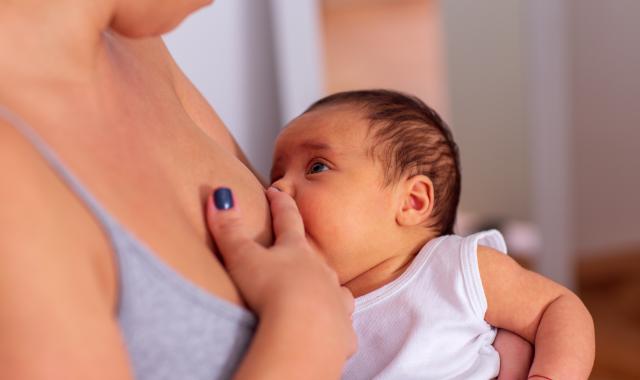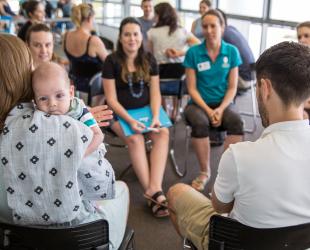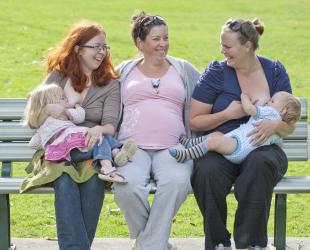Adele's story of one sided breastfeeding
Adele has a super power … it’s her left breast. In this episode she shares her story with Jessica about her experience with one sided breastfeeding and becoming a mum to her four children.

Podcast episode
Companion blog post
Yesterday, I woke up feeling a little sad. My second baby, almost 6 months old, refused my Little Boob; he has been refusing it more and more over the past week, so it didn’t really come as a surprise. Also, my first baby had refused to feed from Little Boob, so I knew this might be a possibility this time around. In fact, many mothers notice that one breast makes more milk than the other and/or that her baby prefers one breast to the other (although many babies will drink from both). However, it is entirely possible to exclusively breastfeed from one side; think twins. But I was still disappointed that baby Will had decided Little Boob was no longer needed. I was dreading years ahead of lopsidedness. I felt like I had failed again.
So, my mind took me on a journey of reflection. My first breastfeeding experience threw me challenge after challenge. My “Super Boob”, as an ABA counsellor had renamed it, produced a good supply and my baby attached well. My underachieving boob, with its odd “bifid nipple”, (picture a flat nipple with a crease down the middle) was hard work for both of us! By the time my first baby was 7 weeks old, I could not feed from Little Boob at all. Determined to continue breastfeeding, I spent hours researching the possibility of one sided breastfeeding. Were there others out there like me?
Podcast information
Adele's story of one sided breastfeeding
Adele has a super power … it’s her left breast. In this episode she shares her story with Jessica about her experience with one sided breastfeeding and becoming a mum to her four children.
Information discussed in this episode:
- One-sided breastfeeding
- How long should I breastfeed my baby? World Health Organization (WHO) recommendations
- Breastfeeding through pregnancy and beyond
- How do I know if my baby is getting enough breastmilk?
- Let-down reflex (milk ejection reflex)
Credits:
This episode is presented by Jessica Leonard. Featuring Adele Calvert.
Audio editing by Taryn Ozorio. Show notes by Belinda Chambers. Transcription by Madina Hajher. Produced by Belinda Chambers, Jessica Leonard and Eleanor Kippen.
[Music, fades to background]
JESS: Welcome to Breastfeeding…with ABA, a podcast about breastfeeding that’s made by parents for parents. In this episode of Breastfeeding with ABA, Adele will be sharing her story of one-sided breastfeeding.
My name’s Jessica and I’m a breastfeeding counsellor with the Australian Breastfeeding Association, I’m also a mum of two children aged 14 and 11. I’m speaking to you from the lands of the Wurundjeri people of the Kulin nation in the Northern suburbs of Melbourne.
I’d like to acknowledge the traditional custodians of the land on which I’m speaking, and you are listening. And I pay my respects to elders, past, present and emerging. I acknowledge the long history of oral storytelling on this country and of women supporting each other to learn to feed their babies.
ADELE: My name’s Adele, I live on Wadawurrung country which is down around the Surf Coast.
JESS: Adele is the person who springs to my mind when people use the frame busy mum, her kids are full of energy, and it means her house is always filled with love. But it’s also meant that she’s had different experiences with breastfeeding.
ADELE: I had my first baby when I was 23, I was living in Melbourne at the time, just me and my partner. It was a very isolating time, that’s what I remember from it.
JESS: But it wasn’t very long before Adele got the chance to breastfeed again.
ADELE: Seventeen months between my first and my second. When I was pregnant again, I really did want to get that breastfeeding right. When he was born, I felt much more confident in being able to advocate for myself and advocate for him in terms of not feeling like I needed to schedule feeds, not feeling like I had to let him cry and just felt like I could trust my instincts more and knowing that there were people out there who did things like that as well and having that support. That just took that weight off my shoulders and before I knew it, I had passed that eight weeks, then my goal was to get to six months, so I had little goals in my head, then my next goal was to get to a year, and then I wanted to get to a ‘WHO baby’.
JESS: I’ll just explain here, if you’re not sure what it means when someone says a ‘WHO baby’ when they’re talking about breastfeeding, it’s about celebrating getting (to) two years of breastfeeding. The World Health Organization’s recommendation is to breastfeed exclusively for six months, then keep breastfeeding along with family foods for two years and beyond, as long as mum and baby wish to continue.
ADELE: I suppose in the beginning it was like, ‘yes, I’m doing this’ and then each goal it was just easier.
JESS: That’s not to say there weren’t any challenges with Adele’s second baby.
ADELE: About six months or so when it really started, he preferred the left side, and I would always continue to offer the right side and then you know switch between feeds of offering the right side first and then the left side first. And I think it sort of came down to that my left side had a quicker letdown, and he just was impatient and didn’t want to wait for that slower letdown of that right side. But also being right handed I found it comfortable to hold him in my left side and being that I had a toddler at home as well as a newborn, I was often walking around feeding a baby, so holding him on that left side while you know, getting a snack for a toddler, while helping her toilet train, while you know doing so much stuff and walking and breastfeeding. Or, um, you know, I was out at a restaurant and I would just pop out that left side, that was my go-to and it just became that it had, it produced more milk, had a quicker letdown, so he started to just drop the right side completely. And once that happened and he was becoming so fussy on the right side, I just stopped offering it completely and we just kept feeding on the left.
JESS: So, Adele kept breastfeeding her baby from one side only. She looked out for signs that he was getting enough milk.
ADELE: He had plenty of wet nappies, he had healthy poos.
JESS: But then came another challenge; Adele was pregnant with her third baby.
ADELE: So, he continued to feed through pregnancy, and I actually had quite intense breastfeeding aversion through that time.
JESS: Breastfeeding aversion is common in pregnant women, not everyone gets it but for some people the combination of sore nipples and hormones collide and make for an agitated and anxious feeling while breastfeeding. Some people choose to wean while they’re pregnant because of it and some people use other strategies to get through it.
ADELE: I found I used a stress ball, and I squeezed the stress ball quite intently and I also found I had to watch TV, and just to distract myself from those feeds.
JESS: Not only did Adele’s breastfeeding aversion go away when she had her third baby, but the one-sided breastfeeding resolved itself as well.
ADELE: He was happy to try the other breast at that point because of course that supply had come back in that right side, but still definitely had that preference and through those early months, Autumn fed on both sides. But very soon again I found I was having another child who was preferring the left breast again. I was confident to just go, “you know what I’m not going to fight this with a fussy baby who’s not at all trying and refusing that breast” and we just went back to the left breast. So, I was tandem feeding two babies on one breast. Pretty much, Harvey would just to maintain that supply he would feed on the right side, but mostly I was feeding two children, one breast, super leftie.
[music fades in]
JESS: Adele has some advice for other people who are dealing with a baby who prefers one breast over the other.
ADELE: Just trusting your body can do what it needs to do, getting that support. Often people look for that support when the problem is already there. My theory when I was pregnant with Harvey, with my second baby, after struggling so much with my first was that no, I want the support before there even is a problem, so I want to have that network created so I’m not trying to find that network, I wanted those like-minded people in my life to be there for me. Really, it’s like, you know yourself and you can trust yourself, but it helps to have people just giving you a little pat on the back because you need it as a mum.
END
-
Access our free info kit.
-
Download our mum2mum app via the App store or Google Play.
-
Call the National Breastfeeding Helpline on 1800 686 268, available 24 hours a day, 7 days a week.
-
Chat with a volunteer via LiveChat on our website.
-
Sign up for an interactive and informative local breastfeeding class or online breastfeeding workshop.
-
Get books and resources on general and specialist breastfeeding topics.
-
Join ABA as a member to get your free copy of our best-selling book Breastfeeding … naturally + free access to all premium content on the mum2mum app + discounted breastfeeding classes + half-price breast pump hire + unlimited access to ABA events + more!



